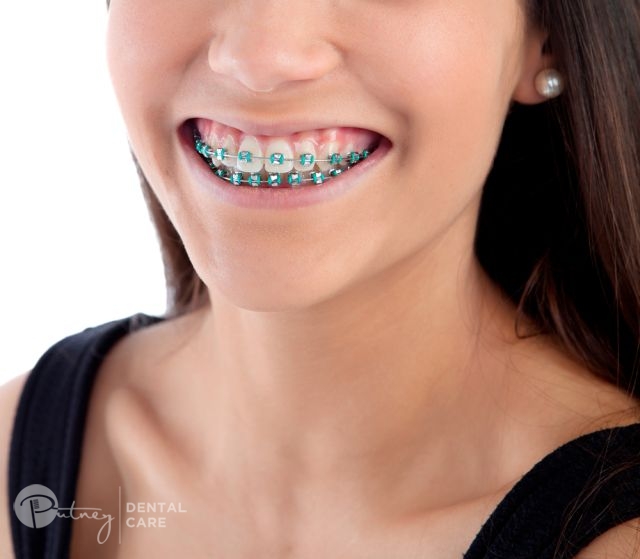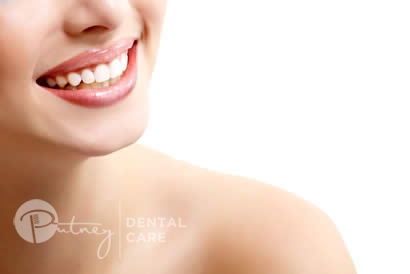How Do Braces Work?

Braces are the orthodontic answer to crooked teeth and persistent bite problems that otherwise might prove to be life-long aesthetic and medical issues. They straighten teeth over time and give wearers a brand-new smile they can proudly show off.
Despite their popularity as orthodontic treatment, how braces work is not common knowledge. Luckily, we have insider knowledge to help you understand what braces do and why they are one of the best options for crooked or crowded teeth.
What are Braces?
Dental braces are available to those who need help moving their teeth to the correct position. They are best used against crowded, misaligned, or crooked teeth. Regardless of the dental issues that need to be addressed, teeth straightening is guaranteed over time as the teeth are slowly shifted into place.
Different types of braces perform these teeth straightening in their unique ways, but all intend on shifting teeth slowly by applying constant pressure in key places.
Mechanics Behind Braces
Most braces straighten crooked teeth by applying pressure on your teeth at certain points to push them into the desired position. While not all patients will require every aspect of orthodontic braces, you can usually see the following:
- Orthodontic bands: Stainless steel bands that are wrapped around molars and premolars to create an anchor for the braces. They usually pull together gapped teeth to provide a strong foundation for the braces and prevent breakages. Orthodontic bands may be cemented in place if needed.
- Spacers: If space between teeth is needed to fit orthodontic bands at the start of treatment, spacers will be used.
- Brackets: Ceramic or metal brackets are bonded to the front of your teeth in small squares to provide the foundation for holding the archwires and ligatures.
- Archwires: These metal wires are threaded through brackets to guide the movement of the teeth. This mechanic is the most common feature to be adjusted during treatment, with occasional tightening needed to straighten crooked teeth.
- Ligatures: These bands can be clear, colourful, or tooth-coloured, and are used to attach archwires to the brackets.
- Elastics: Rubber bands used to correct jaw misalignment by connecting the upper and lower dental arches. They are attached to hooks found on the brackets, and may also contribute additional force to crooked teeth along the periodontal membrane to straighten them.
Types of Braces
Plenty of different types of dental braces are available to choose from when it comes to straightening your smile. Whether you are looking for something more inconspicuous or fast-acting, your dentist will guide you to the best option for you and your teeth.
Traditional Metal Braces
The most commonly known of all traditional braces, metal braces straighten teeth using wire and brackets at the front of each tooth. Bands at the back of the teeth anchor the wires in place.
Treatment with conventional braces such as metal works the fastest out of most braces, but they are more conspicuous than other options.
Ceramic Braces
While working similarly to metal braces, these braces use clear or tooth-coloured ceramic brackets for a more subtle appearance. This material does require some extra maintenance to ensure it does not stain.
Lingual Braces
Lingual braces work much the same as metal braces, only with the brackets and wires being on the inside of the teeth. This discreteness makes them appealing to many patients, especially adults, as there are no cosmetic changes to your smile after installation. Due to their unique placement, extra effort may be needed to clean these braces.
How Do Braces Move Your Teeth?
Simply put, orthodontic braces work by applying pressure over an extended period to push crooked teeth into place for a straight smile. This is possible due to the flexibility of the periodontal membrane under the gums that attaches your teeth to your jawbone.
The application of force causes the membrane to release osteoclast cells, allowing bone remodelling to occur. This is where the osteoclast cells break down and reabsorb bone tissue along the side of the tooth that is receiving force. The constant pressure applied to the tooth allows it to move forward over time and creates a gap where the tooth once sat. This gap then releases osteoblast cells to regenerate the bone tissue and secure the tooth in its new place.
This process is repeated for each necessary tooth, rearranging its position until you achieve your desired smile. The length of time for this process differs between people and is affected by the extent of dental issues that require attention.
Step-by-Step Guide to Brace Installation
Installing braces is fairly simple, requiring only occasional visits for adjustments. Most types of braces follow a similar 4-step guide for their installation and eventual removal, which usually leads to retainer fitting to maintain your smile.
1. Initial Consultation and X-Rays
Getting braces will require an initial consultation with your dentist to assess your teeth and recommend the best treatment option. X-rays will be performed on your teeth and mouth to help in this assessment process.
Photographs of your face, mouth, and teeth will also be taken to determine how your smile should look. If the spacing between your teeth is found to be too tight, spacers will be inserted to prepare your mouth for braces.
No matter the braces your dentist suggested, a mould of your mouth and teeth is required to make them accurately. You will either make an impression by biting into a tray of soft material, or your dentist will take a digital scan.
2. Application of Braces
Applying your braces may take some time, regardless of what braces you choose, but the process is simple enough. Your orthodontist will keep your tongue in place with a device and work to keep your teeth and mouth dry. This is to help apply an etchant to prepare the teeth’s enamel for bonding.
The braces will then be set in place with a special adhesive, cured with a light. The archwire will then be threaded through the braces and held in place with ligature bands.
3. Regular Adjustment Appointments
Your first follow-up appointment to adjust your braces generally comes 4-8 weeks after its application. This is the first of many adjustment appointments throughout your treatment where your progress is catalogued, and your bands are swapped out for new ones to apply further pressure. The archwires may also be adjusted as needed, and you can choose new colours for your braces during this time.
These appointments are typically recommended every 4-8 weeks and may be followed with some discomfort due to the new adjustments.
4. Brace Removal and Retainer Fitting
Once your treatment has been completed, you require one final appointment to remove your braces and get fitted for a retainer if needed.
Braces are easily removed once the bonding material is dissolved. Your teeth’ enamel will also be cleaned and polished after removing everything to leave them shiny and smooth. This entire process only takes around 15 minutes.
Your orthodontist may recommend a retainer to help your teeth ‘remember’ their new position. Wearing it at night will ensure that your teeth do not drift away from their new position and that your smile remains straight.
Braces After-Care
After your braces have been applied, you will have to adjust your cleaning habits to care for them appropriately. This is not just because you may be experiencing some discomfort from the constant pressure of the braces, but also because the brackets and wires are new obstacles to clean around.
Cleaning Your Braces
It is important to use a soft-bristled toothbrush when cleaning your teeth to clear out any plaque or food trapped around your brackets. Remember to also clean under the archwires with the toothbrush’s bristles. Fluoride toothpaste is also recommended to keep your teeth clean and healthy.
Your teeth should be brushed twice daily, with attention paid to each tooth and its bracket to ensure complete cleanliness. Any remaining food should be cleared out with regular flossing and the usage of mouthwash.
Foods to Avoid
To avoid wearing out your braces, you should avoid any sticky or hard foods. This includes apples, chewing gum, popcorn, and hard candy.
Soothing Braces Discomfort
Following the installation or tightening of your braces, you will likely feel discomfort for a while. Most discomfort clears up within a week of your appointment. Still, there are home remedies you can use to relieve the tightening sensation on your teeth and jaw, as well as any increased sensitivity you may be experiencing:
- Drink ice water or place an icepack on the outside of your mouth
- Rinse your mouth with warm water
- Use orthodontic wax
- Massage your gums
- Use topical anaesthetics or over-the-counter pain medication
- Eat only soft foods
Benefits of Wearing Braces
There are many benefits to choosing braces as an orthodontic treatment to straighten misaligned teeth, including improving your oral health and confidence in your smile. Some of the more notable benefits of wearing braces include:
Better Oral Hygiene
Your oral health can be greatly improved after using orthodontic braces. It is harder to brush and floss your teeth when they are crooked, as much of their enamel may be unreachable due to their placement. Straight teeth are much easier to maintain.
Furthermore, food, bacteria, and other debris are more easily caught up in crowded teeth. Once your teeth are straightened, there is less of a chance of these materials building up between your teeth and gums to cause future health problems. Preventing issues such as gum disease or tooth decay will allow you to maintain your smile and not face a chance of tooth loss.
Increased Confidence
Many people choose to get braces for cosmetic reasons, as straightening teeth can greatly provide confidence in your smile. Straight teeth are something to be proud of, and you will want to show them off once your braces are off.
Improved Speech
There are some cases where crooked teeth can affect how you speak. However, this issue can be resolved by straightening your teeth and allowing you to speak clearly once more.
Correct Bite Issues
While teeth straightening may be one of the main focuses of braces, exerting constant pressure can also improve potential bite issues. Misaligned teeth can cause issues such as teeth grinding or constant clenching that can damage the enamel and pose problems with your bite.
Addressing these bite issues and moving teeth into their correct position can also prevent you from inflicting any injuries on yourself. Protruding teeth and misaligned jaw lines can raise your chances of accidentally injuring yourself, so moving them into place can prevent this from happening.
Prevent Bone Erosion
Overlying teeth normally apply even pressure to our jawbones, promoting bone growth while keeping the jawbone healthy. However, when teeth are not correctly aligned, specific jaw areas will experience more pressure. Constant negative pressure can lead to bone erosion, which is why straightening your teeth as soon as misalignment is noticed is best.
Aid in Digestion
Teeth are an instrumental tool in the digestive process as they break down and grind up food into manageable pieces. Crooked teeth prevent this process, which can negatively affect your digestion and cause persisting issues unless braces are applied.
Alternatives to Braces
If braces are not your orthodontic treatment of choice, there are alternative cosmetic optics available to help you achieve that straight smile of your dreams.
Tooth Reshaping
For those who only have a minor flaw in their smile, braces can seem like a lot of work to fix one or two misaligned teeth. That is why tooth reshaping, also known as dental contouring, can be used instead to shorten longer teeth or reshape the structure of misaligned teeth.
The procedure requires a small piece of a tooth’s enamel to be removed, correcting a range of cosmetic issues as needed. The efficiency of this treatment makes it appealing to many.
Veneers
Whether you prefer composite veneers or porcelain veneers, your smile can be greatly improved by placing a veneer over your existing teeth. The procedure for both options can be done in one visit to the dentist, where the veneers are shaped directly onto your teeth to fill any obvious gaps between teeth and reshape them into a straight line. They can even improve the appearance of cracked or stained teeth.
Orthodontic Surgery
Also known as jaw surgery, orthodontic surgery works to realign the jaws and teeth to improve irregularities of the jaw bones. This option is generally recommended when orthodontics alone cannot correct bite problems or misaligned teeth. However, you may still require braces before and after surgery to ensure perfectly straight teeth for the rest of your life.
Get Your Perfect Smile: Contact Us For A Consultation!
By answering the question of how braces work, we hope that you feel confident and ready to book your first consultation with us at Putney Dental Care.
The initial consultation is free as we want you to be fully informed of your options and committed to the idea of wearing orthodontic braces to straighten out your teeth into the smile you have always deserved. Our team of experienced orthodontists will also provide excellent care throughout the entire braces process, so you will always have support by your side.
To contact us for that free consultation, give us a call at (02) 9808 2588. Otherwise, you can book online and set up your appointment yourself. Either way, your perfect smile is ready and waiting at Putney Dental Care.
FAQs
How often do I need to visit the orthodontist during treatment?
Most traditional braces require a visit every 4-8 weeks to ensure your teeth are progressing correctly. Your orthodontist will advise you at each visit when your next visit should be.
Can adults wear braces?
Adults can wear braces as there is no cut-off age for getting braces. Treatment may take longer as an adult due to the length of time teeth have had to move out of place, especially if other dental issues are present. However, the result is the same with a perfectly straight smile.
What is the impact of braces on my speech?
Most types of braces will not generally impact the way you speak, but those with brackets on the inside of the teeth may cause a temporary lisp. For example, lingual braces may require an adjustment period before the lisp or difficulty in saying specific words is overcome.
Can I play sports or musical instruments while wearing braces?
You can continue to play sports or musical instruments while wearing braces, but adjustments may be required before your performance returns to normal. For sports, this means wearing a mouthguard to protect your teeth and gums from your braces. In contrast, musical instruments may require an adjustment to how you play if it is an instrument that requires the use of your mouth.
Will I need to wear a mouthguard while sleeping?
You are not required to wear a mouthguard while sleeping, but those who grind their teeth or have protruding teeth may prefer it to protect your mouth.
What to do in case of an orthodontic emergency If I have braces?
Depending on the cause of the emergency, booking an immediate appointment for repairs may be required. If you have a wire out of place or poking out, it is best to cover it in dental wax before your appointment to prevent it from moving further or hurting your mouth.
Do braces interfere with MRI scans or other medical tests?
It is safe to get an MRI scan with braces as the small amount of metal will not interfere greatly with the image or pose an issue to your health. Most other medical tests will also be okay with the presence of braces, but it is always best to inform your medical professional beforehand so they are aware.
3 Stages of Recovering from Dental ImplantsLatest from the Dental Blog
 29 Jun 2022
29 Jun 2022
Cavity vs Stain – Understanding the Differences
Wondering if you have a tooth cavity or simply a stain on your tooth? It can be tricky to tell…
 05 Feb 2017
05 Feb 2017
Love your smile this Valentine’s Day with Teeth Whitening
When it comes to whitening the more active ingredients the product contains the more effective it will be. What are…
 13 Sep 2017
13 Sep 2017
Health Issues Dentists Can Spot Right Away
Are you feeling the ache of inflamed gums? Do you experience pain when eating or have sensitive spots in your…
